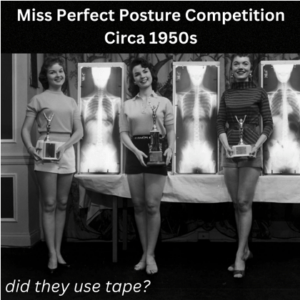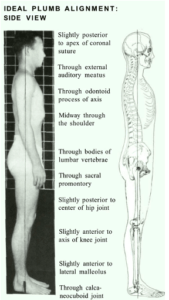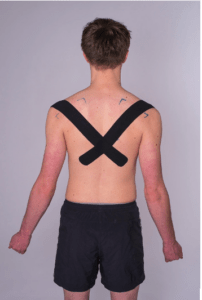At some point in our evolutionary journey posture became one of the defining visual features of our dominance, spending more time on two legs, and becoming more upright. In more recent centuries, the importance of posture has permeated many echelons of society, including military parades, where some soldiers sometimes look so upright, they are at risk of falling backwards. For some, posture also became associated with good character, and beauty.
In the 1950s-60s American Chiropractors held Miss Correct Posture competitions using various measures including X-rays. I must admit they do have good posture, although the lady in the middle has a right sided cranial deviation (Joke).
How to win a Perfect Posture Competition
As defined by Kendall et al (1993) perfect posture can be defined as a vertical plumb line passing down through the body relative to set anatomical points as shown and referenced in the diagram.
The peculiar thing about this reference standard is its rigid application, labelling people with either good or bad posture.
All other tests of health, such as blood tests, fitness tests and even urine samples are reported in terms of ‘normal ranges’ rather than exact measures. It is well known that the human form varies considerably between individuals and within individuals during the aging process.
Therefore, were these nineteenth century posture devices (shown below) helpful health devices or tools of torture. I can visualise well-meaning nannies insisting the children fit these so they don’t end up like their great aunt Agnus, who probably suffered from curvature of the spine caused by osteoporotic wedge fractures and was not a victim of excess reading.
Posture and Pain
Poor posture has been blamed for most things, and pain is no exception. Back pain, neck pain, and shoulder pain are perhaps most attributed to posture. Is this evidence based and is this fair?
With a focus on posture and shoulder pain, static positions, muscle imbalances and faulty movement patterns have all been associated with pain.
The most identified static position fault are rounded shoulders, also known as forward head posture or even just slumping and slouching.
The most well-known muscle imbalances relate to chest muscle tightening and upper back muscle lengthening. This pattern is often called upper crossed syndrome (Janda 1987).
The most identified faulty movement pattern is called scapular dyskinesis, which is a term for a scapular which does not perform the expected rhythm around the rib cage during arm elevation.
Distilling the truth
Like any good science, the study of posture should lead us to learn and update our knowledge. There remain many postural questions but based on the evidence available we may conclude the following posture points.
1: Postural deviations may or may not cause or contribute to pain. Perform a posture pain test by asking the patient to perform a meaningful movement before and after adjusting the posture. If the posture adjustment helps then consider it as a potential treatment approach. Postural deviations can also be caused by the avoidance of pain, or just skeletal structure.
2: If you were to perform a strict standing posture measurement for everyone who stepped in your clinic you would be diagnosing most people with some form of posture problem. Don’t be that therapist that discharges people with more problems than they started with. Could you tell people (whenever possible) that their posture is within normal range, or perhaps not the cause of their problem?
3: Posture is often associated with wellbeing, feeling good or feeling bad, upbeat, or heavily burdened. Posture speaks to people through body language which is one reason why people often feel healthier and happier when they make a conscious effort to improve their posture through exercise and awareness. These positive health behaviours may indirectly reduce pain and improve quality of life.
Lets use our knowledge and awareness of posture positively by avoiding the binary perfect posture fallacy and instead promoting movement over rigidity and embracing differences over conformity.
RockTape Education
We use our knowledge of posture and pain to inform our teaching. Our Advanced taping course features a shoulder pain workshop that incorporates posture/pain testing. RockTape also encourages movement and does not hold people in fixed postures. Overall RockTape provides a flexible and versatile approach to musculoskeletal pain management.
Here is an image of my favourite posture taping application.
And here is a link to the related application video: https://youtu.be/j87w5oTDfXw?si=4eGHc9grWkya_YAw
Our next course is in Brighton in March LINK: https://www.rocktape.co.uk/product-category/education/face2face-courses/
We also have a pre-recorded (non-certifying) course and plenty of videos on the YT channels: https://www.rocktape.co.uk/education-overview/online/
RockTapeUK: https://www.youtube.com/@RocktapeUKYT
ThePhysioChannel: https://www.youtube.com/@ThePhysioChannel



